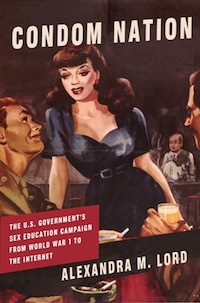Uncle Sam's Birds and Bees

Sex education has always seemed like a counterintuitive enterprise to me—which doesn’t reduce its importance in a culture which, at the least, broadcasts mixed messages about sexuality and human relations.
And, of course, government involvement in sex education continues to be a controversial issue. Thus a book like Condom Nation:The U.S. Government’s Sex Education Campaign from World War I to the Internet (Johns Hopkins University Press), by former U.S. Public Health Service historian Alexandra M. Lord, is a well-documented survey and commentary of federal government efforts, mainly through the U.S. Public Health Service.
(This despite the book’s comic-book-style cover and its clever though misleading title—as Susan Jacobs points out, the U.S. has one of the highest teen pregnancy rates in the developed world.)
Not surprising then that those initiatives have been less than successful especially as they were required to balance public health interests with various cultural concerns. Additionally, the involvement of a hodge-podge of community organizations, public schools, foundations, corporations, and religious groups almost insured ongoing controversy in an already volatile area. As Jacobs points out:
As Lord observes, public sex education programs—especially in dealing with contraceptives—have always been hampered by the perceived conflict between effective medicine and morality as defined by the most conservative religious and cultural forces in American society. It is as though the Public Health Service were asked to fight non-sexual infectious diseases without promoting hand-washing and antiseptics… It also is a sobering tale of the ways in which racial and religious biases, unmoored from scientific evidence, can derail a public mission that ought to be dedicated to improving the health of all citizens. Whether the lesson has been learned, or whether unreason will return in future government-funded attempts to teach a particular version of sexual morality, remains an open question.
